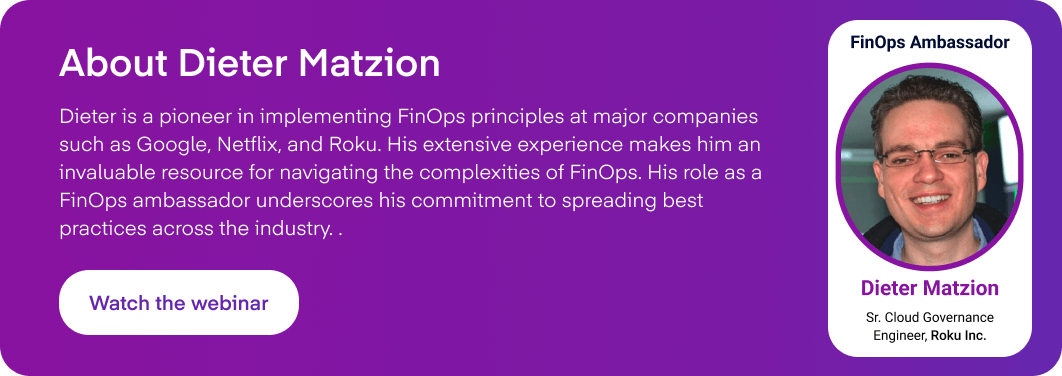Maximize cloud usage and cost efficiency using FinOps best practices

This blog post is a detailed recap of a recent Platform9 webinar led by FinOps ambassador Dieter Matzion, who shared invaluable insights into how to use FinOps best practices to improve cloud usage and cost efficiency. For those interested in learning more, the complete webinar recording is available here.
What is FinOps and why it’s important
FinOps combines financial accountability with cloud operations, ensuring cost-efficient and effective cloud usage. This practice is crucial for businesses to thrive in a technology-driven marketplace. FinOps helps organizations manage cloud costs proactively, rather than reactively. It involves collaboration across multiple departments, including finance, operations, and engineering.
FinOps is more than just cost management; it’s a strategic practice that integrates financial accountability directly into the dynamic environment of cloud technology.
The FinOps framework
The FinOps Foundation offers a structured framework that details how organizations can implement FinOps effectively. This framework is essential for setting up a successful FinOps practice. The framework outlines roles, responsibilities, and phases of cloud cost management. It emphasizes the importance of maturity and capability in managing cloud expenses.
FinOps principles
The core principles of FinOps include collaboration, ownership of cloud usage, and making decisions driven by the business value of cloud services. These principles are designed to foster a culture of cost transparency and accountability.
- Every team member is responsible for their cloud resource usage.
- Strategic decisions should align with the overarching business objectives.
The FinOps Framework isn’t just a set of guidelines—it’s a roadmap for companies to achieve financial clarity and efficiency in cloud investments.
Rate and usage optimization
Understanding the basic cloud equation, “Rate x Usage = Cost,” is crucial. Dieter discussed strategies for both rate and usage optimization, which can significantly affect the overall cloud spend.
- Rate optimization is generally easier and can be executed centrally.
- Usage optimization, though more complex, provides substantial cost-saving opportunities when implemented correctly.
Challenges of low resource utilization in the cloud
Many organizations face challenges with resource utilization, leading to significant waste. Dieter provided statistics and case studies, illustrating common pitfalls, including:
- Statically provisioned VMs / databases idle off-peak
- Statically provisioned test environments idle outside of business hours
- Orphaned / forgotten resources after decommissioning workload
- Inefficient autoscaling leaves VMs running for too long after scaling in
Even small inefficiencies at scale can lead to substantial unnecessary costs.
Organizational challenges in implementing resource utilization principles
Adopting FinOps practices involves overcoming internal resistance and external pressures. Dieter discussed how fostering a culture of optimization and collaboration can address these challenges.
- Changing the organizational mindset towards cloud cost optimization is essential.
- Cross-functional collaboration enhances the effectiveness of FinOps practices.
Implementing FinOps is as much about changing hearts and minds within the organization as it is about changing technologies and processes.
Best practices for overcoming challenges
Establishing clear goals, investing in automation, and fostering a learning culture are critical for overcoming the challenges associated with implementing FinOps principles.
- Regular progress measurement and recognition are important for motivating teams.
- A strong governance framework contributes to long-term cloud cost management success.
Dieter Matzion’s webinar provides valuable insights for anyone looking to improve their organization’s cloud usage and cost efficiency. The principles and strategies discussed here can change how organizations manage their cloud resources, resulting in significant financial and operational benefits.
Kubernetes FinOps and Platform9 Elastic Machine Pool (EMP)
EMP is an integrated solution for achieving your Kubernetes FinOps objectives. EMP’s unique approach creates a cost-effective virtualization layer on AWS bare metal. It then employs tried-and-true virtual machine technologies such as over-provisioning and live migration to improve the resource efficiency of workloads without disrupting pods or requiring application changes. See for yourself how Elastic Machine Pool can transform your EKS infrastructure, resulting in significant cost savings and efficiency improvements. Request a demonstration from our founders and solution experts.

